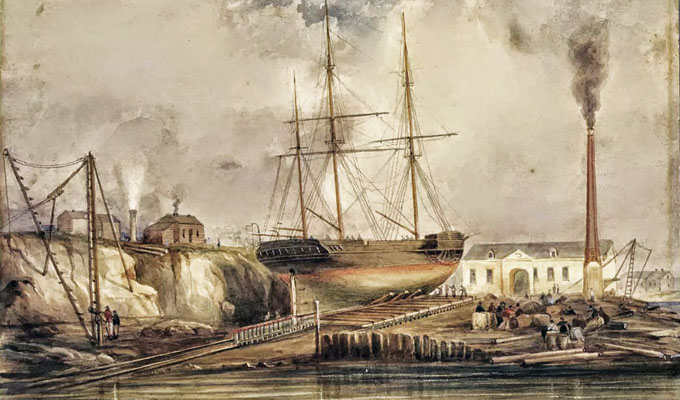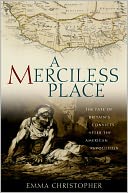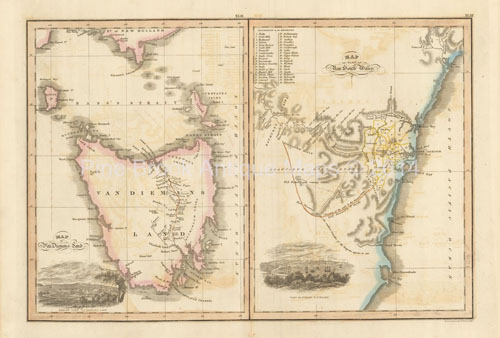Australia

Australia: ° Adelaide ° Brisbane ° Darwin ° Fremantle ° Hunter Islands ° Lord Howe Island ° Melbourne ° Perth ° New South Wales (Sydney) ° Norfolk Island ° Van Dieman's Land: Tasmania (Hobart Town, Port Arthur)
Lord Howe Island

Lord Howe Island, in the Tasman Sea off the east coast of Australia, was first visited by Europeans on 17th February, 1788 by Lieutenant Henry Lidgbird Ball, commander of the armed tender of the First Fleet, HMS Supply.
His Majesty's Brig Supply, 1790, off Lord Howe Island. And His Majesty's Ship Sirius in Sydney Cove 1789. Painting by George Raper, 1792.
The Supply was one of the escorts of the First Fleet of convict ships to Botany Bay.

Purportedly, no one actually lived there before 1834. It was inhabited by 13 species of birds found nowhere else on the planet: The island’s unique species of birds can be seen throughout the island; the Lord Howe Woodhen, Golden Whistler, Silvereye and Currawong are found nowhere else in the world. The island is seasonal habitat to millions of seabirds such as Noddy terns, White terns, Sooty terns, Muttonbirds, Black winged petrels and Red-tailed tropic birds. Some migrate from as far as Siberia each year to breed. (Nine are now extinct.) The island also has scores of endemic plants. S
Lieutenant Ball was sailing from First Fleet headquarters in Sydney Cove to Norfolk Island where it was intended to found a second colony. Ball did not land on Lord Howe Island until 13th March, 1788, on his return journey, when men from the Supply came ashore to explore the newly discovered island and claim it in the name of the Colony of New South Wales.
The first settlers were three Englishmen from New Zealand. Their names – Ashdown, Bishop and Chapman – have the ring of a firm of family solicitors. In a part of the ocean where islands were in short supply, particularly ones with fresh water and neither unfriendly natives nor meddlesome officials, A, B and C saw an opportunity for victualling whaling ships. They grew vegetables above what is now Old Settlement Beach, and introduced pigs and goats, whose descendants eventually had to be eradicated to repair the island's pristine ecosystem.

Many place names of the Island date to this first visit. The Island was named after Lord Howe, who was the First Lord of the Admiralty at the time. Ball’s Pyramid and Mount Lidgbird were named after Lieutenant Henry Lidgbird Ball.
In that same year a number of other First Fleet ships visited the Island. Some of the sailors who came ashore made diary notes and even sketches of the Island and its birdlife.
Whaling Ships
From 1800 onward, Lord Howe Island became a well known stopover for whaling ships to obtain food and water.
New South Wales Lagoon, Lord Howe Island

In 1830,1830 whaling Brig George, 185 tons, hit a rock (now George’s rock) off the south east side of Mount Gower. The George was said to have been carrying a chest of gold coins, which the crew got ashore in the lifeboat, but this has never been found.
By 1833 three men came to live on the island to supply food to the ships crews. Messrs Ashdown, Bishop and Chapman, accompanied by their Maori wives and two Maori boys arrived from New Zealand on the barque Caroline. They settled at Hunter Bay, now known as Old Settlement, where they engaged in supplying ships with meat, fish and vegetables in exchange for other goods. They continued at Lord Howe until 1841 when Captain Owen Poole, retired naval officer, and Richard Dawson purchased their holdings for 350 pounds.
Being a remote island 500 km from any other land, Lord Howe Island naturally has a rich maritime heritage. As did all island nations, the residents of Lord Howe Island relied upon passing ships to bring news of the outside world, supplies and passengers.
The first regular trading vessel to the Island was the barque Rovers Bride, which commenced voyages in the 1840s. She was followed by a succession of similar small sailing vessels such as Sylph and Comet. In 1893 the Burns Philp company commenced a regular steamship service to the island.
Later, in 1841, Poole took to the Island Messrs Wright, Hescott & McAuliffe and their wives. Thomas and Margaret Andrews arrived on the barque Rover’s Bride in 1842. All were employed to help carry on the industry commenced by Ashdown, Bishop and Chapman. In 1844 Dr John Foulis, who had bought a half of Poole’s share, arrived with his wife and daughter and four English emigrants.
August 19, 1856, The Sydney Morning Herald, New South Wales
Colonial Whalers at Sea
With Their Last Reports
- Caernarvon, barque, 222 tons, Eury, hence, February 12th, 1856 R. Towns, agent.
- Daniel Watson, brig, 160 tons, Phillips, hence, February 3. Reported in March, at Howe's Island, one whale. Smith, agent.
- Independence, brig, 199 tons, Peters, hence, 1st June, 1856. R. Towns and Co., owners.
- Jane, barque, 356 tons, Wybrow, hence, 28th March, 1856. Reported in March, at Howe's Island, clean, R. Towns, agent.
- Kate, brig, 281 tons, Sargent, hence, 19th April. Reported on 9th June, with 70 barrels. T. Dawson, owner.
- Kestrel, brig, 150 tons, Sullivan, hence, 21st October, 1855. Reported in March, at Howe's Island, clean. Merriman, agent.
- Lady Blackwood, barque, 253 tons, Oliver, hence, March 11. Re-
ported on 10th April, clean. R. Towns and Co., owners.
Onyx, barque, 259 tons, Hurford, hence, June 5,1856. R. Towns and Co., owners. - Post Boy, schooner, 96 tons, Field, hence, March 3, 1856. T. Dawson, owner.
- Panama, brig, 190 tons, Bushell, hence, 19th April. Reported May 9, with 60 barrels. R. Towns, owner.
- Regia, brig, 181 tons, Johnson, hence, November 1st, 1855. Reported February 15, with 75 barrels. Thacker and Co., agents.
- Royal Sovereign, schooner, 100 tons, Needham, hence, 26th Ocotober, 1855. R. Towns, agent.
- Susan, brig, 230 tons, Hoodley, hence, 21st October, 1855. Reported in March, with 80 barrels. Smith, agent.
- Sutton, barque, 282 tons, McBeath, hence, October 3, 1855. Cole, owner.
- Vernon, brig, 230 tons, Spurling, hence, April 6th, 1856. Smith, agent.
- Waterwitch, barque, 382 tons, Lee, hence, 5th September, 1855. Reported April, with 180 barrels. Smith, agent.
- Woodlark, barque, 190 tons, Cook. Reported in March, at Howe's Island, clean, R. Towns, owner.

With the decline of whaling in the 1870s, Lord Howe's growing population needed another money-earner. They turned to the kentia – or thatch – palm, a decorative plant endemic to the island that thrived 'in captivity' in the northern hemisphere. It has defined the Palm Court and Winter Garden for 140 years and still adds a sprig of exotica to smart foyers the world over. Between two and three million palm seedlings are exported each year. Kentia palms, fishing and tourism are the island's only industries, the 15,000 tourists a year adding more than A$25 million to the island's coffers.
Sources include: Lord Howe Island Museum, The London Telegraph
Brunel in South Wales:
Communications and Coal
Stephen Jones
Brunel in South Wales:
Volume 3: Links with Leviathans
Stephen Jones
Isambard Kingdom Brunel had strong associations with South Wales; chief engineer of the GWR at just 27, he was the same for the South Wales Railway Company, taking the railways across South Wales. This illustrated history focuses on Brunel's contribution to the maritime world, from his work on dry docks and shipping facilities to his steamships, including his 'great leviathan'.
The Fatal Shore
The Epic of Australia's Founding
Robert Hughes
Superbly researched and brilliantly written. The birth of Australia from England's brutal convict transportation system.
Charles Dickens' Australia.
Selected essays from Household Words 1850-1859
Book Two: Immigration
Margaret Mendelawitz
Starting as a court reporter, parliamentary newspaper columnist and theatre critic, he developed an instinct for injustice, humbug and charade. For 20 years he edited his own weekly journal, 'Household Words', later known as 'All the Year Round', publishing articles and stories designed to be interesting, entertaining, and educational. Dickens had a keen interest in Australia and fortuitously began publishing the periodical at a transitional moment, just before the heady days of the 1850s gold rush set the world ablaze. The discovery of gold drove a period of mass immigration, expansion into the hinterlands, and caused radical economic and social changes in an emerging nation. Of the nearly 3000 articles published in 'Household Words', some 100 related to Australia and have been collected in this anthology. Dickens saw Australia offering opportunities for England's poor and downtrodden to make a new start and a brighter future for themselves; optimism reflected in many of the articles.
 A Merciless Place: The Fate of Britain's Convicts after the American Revolution
A Merciless Place: The Fate of Britain's Convicts after the American Revolution
Emma Christopher
The fate of British convicts is a dramatic story—the saga of forgotten men and women scattered to the farthest corners of the British empire, driven by the American Revolution and the African slave trade. A Merciless Place captures the story of poverty, punishment, and transportation. The story begins with the American War of Independence which interrupted the flow of British convicts into America. Two entrepreneurs organized the criminals into military units to fight for the crown. The felon soldiers went to West Africa's slave-trading posts just as the war ended; these forts became the new destination for England's rapidly multiplying convicts. The move was a disaster. To end the scandal, the British government chose a new destination, as far away as possible: Australia.
Van Diemen's Land, New South Wales. Wyld. 1827
A Lady's Visit to the Gold Diggings of Australia in 1852-53
Ellen Clacy
An 1853 account of a trip by Mrs Charles (Ellen) Clacy (1830-1901) to the Australian goldfields. Essentially a guide for prospective emigrants, with much practical advice within the narrative, this books sheds light on early Australian social history and hints at problems in the author's outwardly respectable life.
Among Australia's Pioneers
Chinese Indentured Pastoral Workers on the Northern Frontier 1848 to c.1880
Margaret Slocomb
The almost simultaneous abolition of the slave trade and the cessation of convict transportation to the colony of New South Wales started a quest by the squatter pastoralists for alternative sources of cheap labor for their vast sheep runs. Over a period of five years, beginning from 1848, around three thousand Chinese men and boys from Fujian Province were recruited under conditions little different from the slave trade.Athor Margaret Slocomb focuses on the experiences of approximately two hundred of these Chinese laborers between 1848 and 1853.
True History of the Kelly Gang
A Novel by Peter Carey
Winner of the 2001 Booker Prize.

Australia Sea Stories:
Fiction and Non-Fiction
Australians: Eureka to the Diggers
Author Thomas Keneally is a novelist, playwright, and nonfiction author who is best-known for the Booker Prize–winning novel Schindler's Ark, which was adapted into the movie Schindler's List. His other titles include the Penguin Lives biography Abraham Lincoln, American Scoundrel: The Life of the Notorious Civil War General Dan Sickles, and A Commonwealth of Thieves: The Improbable Birth of Australia.
Four Seasons of Mojo
An Herbal Guide to Natural Living
Stephanie Rose Bird
Useful ideas unrestricted by geographic borders, ethnicity, religion, or magical path. Included are recipes and concepts from the Caribbean, African American soul food, Buddhist Meditation practices, sacred Hindu rites, Old European traditions, Australian Aboriginal dreaming lessons, and Native American wisdom.
"Four Seasons of Mojo" infuses ancient techniques, rituals, and methods from around the world to use each season''s inherent energies to supplement body, mind, and soul.
A Selection of Books about
Australian Mining Companies
The Gold Rush
The Fever That Forever Changed Australia
David Hill
Australia's incredible gold rushes of the mid-to late-1800s produced tremendous wealth and ensured the financial survival of the struggling Australian colonies. They also tripled the country's small population, halted convict transportation, subverted the hierarchical British class system, laid the foundations of the Australian egalitarian ethos, and stimulated the democratic ideas that led to the establishment of the nation of Australia. David Hill recreates this monumental turning point in Australia's history using diaries, journals, books, letters, official reports, Parliamentary enquiries, and newspaper reports of the time, along with his own storyteller's skill of bringing the past to life from New South Wales and Victoria, up to Queensland and the Northern Territory, then down to Tasmania and across the great deserts of Western Australia.









 Copyright ~ 1998-2018.
Copyright ~ 1998-2018. 